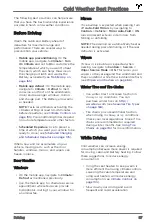
The instrument panel displays a message
indicating that Autosteer is temporarily
unavailable if you attempted to engage
Autosteer when driving at a speed that is not
within the speed required for Autosteer to
operate. Autosteer may also be unavailable if
it is not receiving adequate data from the
camera(s) or sensors.
If Autosteer is unable to detect lane markings,
the driving lane is determined based on the
vehicle you are following.
In most cases, Autosteer attempts to center
Model S in the driving lane. However, if the
sensors detect the presence of an obstacle
(such as a vehicle or guard rail), Autosteer
may steer Model S in a driving path that is
offset from the center of the lane.
WARNING:
Autosteer is not designed
to, and will not, steer Model S around
objects partially or completely in the
driving lane. Always watch the road in
front of you and stay prepared to take
appropriate action. It is the driver's
responsibility to be in control of
Model S at all times.
WARNING:
Steering is limited when
Autosteer is enabled. Therefore,
Model S may not be able to handle
tight turns. Be prepared to take
control of the vehicle at all times.
Restricted Speed
Autosteer is intended for use only by a fully
attentive driver on freeways and highways
where access is limited by entry and exit
ramps. If you choose to use Autosteer on
residential roads, a road without a center
divider, or a road where access is not limited,
Autosteer may limit the maximum allowed
cruising speed and the instrument panel
displays a message indicating that speed is
restricted. The restricted speed will be the
speed limit of the road plus 10 km/h.
In situations where the speed limit cannot be
detected when Autosteer is engaged,
Autosteer reduces your driving speed and
limits the set speed to 70 km/h. Although you
can manually accelerate to exceed the limited
speed, Model S may not brake for detected
obstacles. Autosteer slows down to the
limited speed when you release the
accelerator pedal. When you leave the road,
or disengage Autosteer by using the steering
wheel, you can increase your set speed again,
if desired.
Hold Steering Wheel
Autosteer uses data from the camera(s),
sensors, and GPS to determine how best to
assist you in steering Model S. When active,
Autosteer requires you to hold the steering
wheel. If it does not detect your hands on the
steering wheel for a period of time, a flashing
white light appears along the top of the
instrument panel and the following message
displays:
Autosteer detects your hands by recognizing
light resistance as the steering wheel turns, or
from you manually turning the steering wheel
very lightly (without enough force to retake
control).
NOTE:
When your hands are detected, the
message disappears and Autosteer resumes
normal operation.
NOTE:
Autosteer may also sound a chime at
the same time that the message is initially
displayed.
Autosteer requires that you pay attention to
your surroundings and remain prepared to
take control at any time. If Autosteer still does
not detect your hands on the steering wheel,
the request escalates by sounding chimes
that increase in frequency.
If you repeatedly ignore Autosteer's prompts
for having your hands on the steering wheel,
Autosteer disables for the rest of the drive
and displays the following message. If you
don't resume manual steering, Autosteer
sounds a continuous chime, turns on the
warning flashers, and slows the vehicle to a
complete stop.
For the rest of the drive, you must steer
manually. Autosteer is available again on your
next drive (after you stop and shift Model S
into Park).
Autosteer
100
MODEL S OWNER'S MANUAL
















































